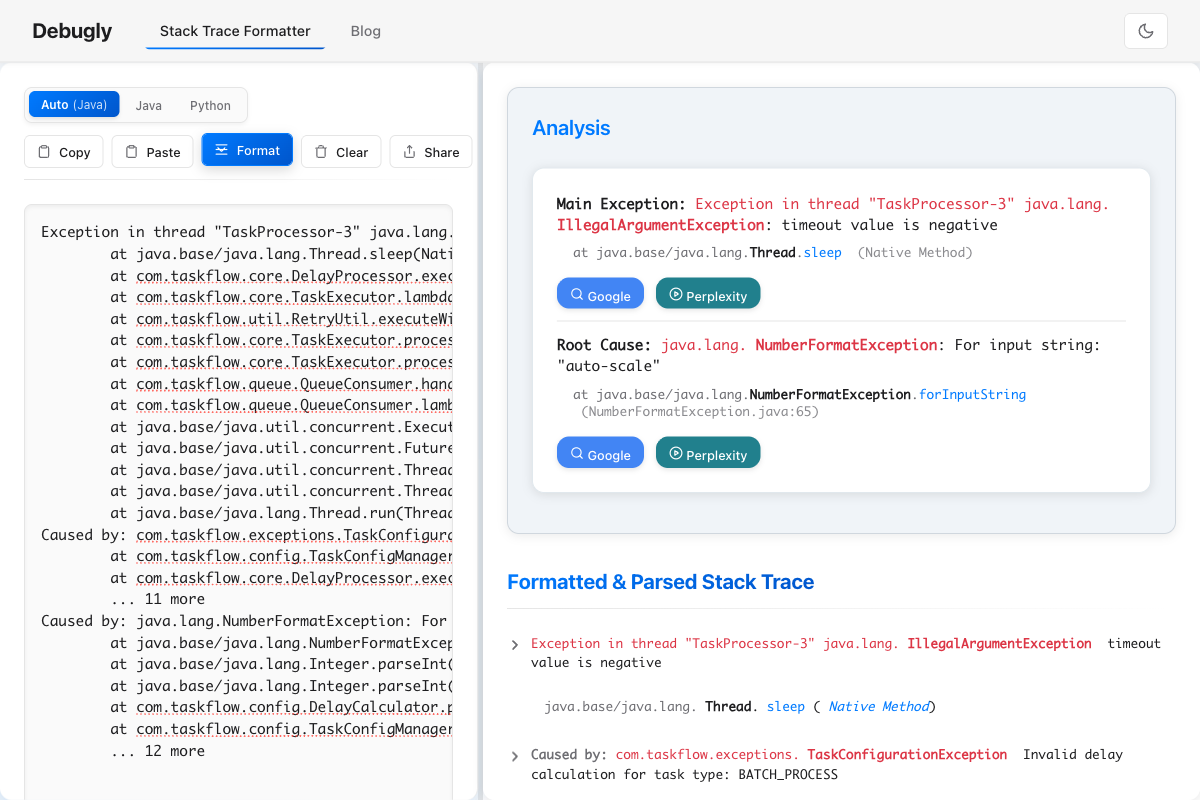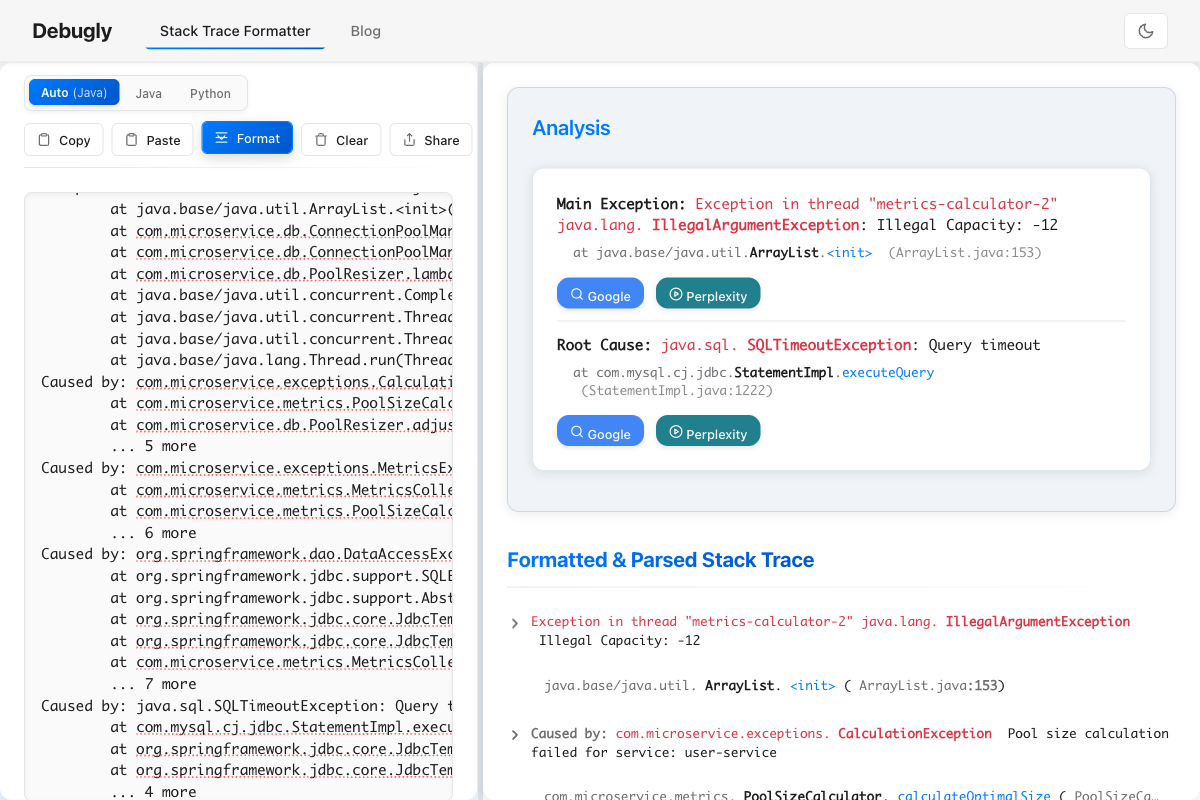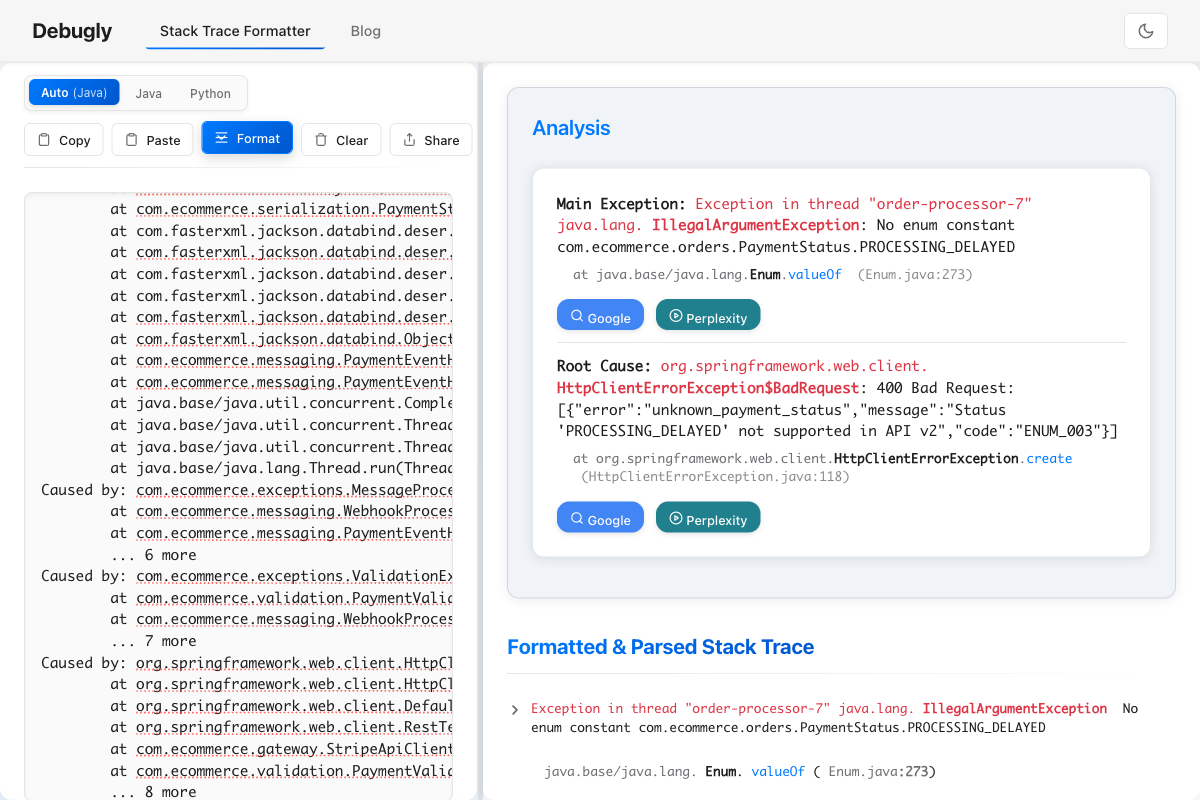IllegalArgumentException errors can be frustrating to debug when buried in complex stack traces. Raw traces often hide the real problem behind framework calls and nested exceptions.
TLDR - Debug Complex IllegalArgumentException Traces Fast
Problem: IllegalArgumentException often gets buried in long, confusing stack traces with nested “Caused by” exceptions.
Solution: Use Debugly’s formatter to:
- See the real root cause - Navigate through nested exceptions easily
- Clean formatting - Method calls clearly separated from framework noise
- Instant search - Click to Google/Perplexity search with exact error details
- Visual hierarchy - Main exception → nested causes shown clearly
Try it with your trace → Paste any complex stack trace, get instant analysis.
Debugly’s stack trace formatter transforms messy traces into clear, hierarchical displays that reveal root causes instantly. This guide examines three production scenarios: async task failures, database pool errors, and API integration issues.
Why Stack Trace Formatting Matters
Raw Java stack traces can be overwhelming, especially when debugging parameter validation errors. They often include:
- Long method names and class paths
- Multiple levels of method calls
- Framework-specific traces that obscure the actual problem
- Poor formatting that makes it hard to scan quickly
Debugly’s stack trace formatter addresses these issues by highlighting the most important information and presenting it in a clean, scannable format.
Scenario 1: Nested Exception in Async Task Processing
Let’s start with a realistic scenario from a distributed task processing system. A background job scheduler is trying to process tasks with dynamic delays, but the calculation results in negative values deep within nested method calls. Here’s the raw stack trace:
Exception in thread "TaskProcessor-3" java.lang.IllegalArgumentException: timeout value is negative
at java.base/java.lang.Thread.sleep(Native Method)
at com.taskflow.core.DelayProcessor.executeDelayedTask(DelayProcessor.java:89)
at com.taskflow.core.TaskExecutor.lambda$processWithRetry$2(TaskExecutor.java:156)
at com.taskflow.util.RetryUtil.executeWithBackoff(RetryUtil.java:45)
at com.taskflow.core.TaskExecutor.processWithRetry(TaskExecutor.java:154)
at com.taskflow.core.TaskExecutor.processTask(TaskExecutor.java:78)
at com.taskflow.queue.QueueConsumer.handleMessage(QueueConsumer.java:203)
at com.taskflow.queue.QueueConsumer.lambda$startPolling$1(QueueConsumer.java:167)
at java.base/java.util.concurrent.Executors$RunnableAdapter.call(Executors.java:515)
at java.base/java.util.concurrent.FutureTask.run(FutureTask.java:264)
at java.base/java.util.concurrent.ThreadPoolExecutor.runWorker(ThreadPoolExecutor.java:1128)
at java.base/java.util.concurrent.ThreadPoolExecutor$Worker.run(ThreadPoolExecutor.java:628)
at java.base/java.lang.Thread.run(Thread.java:834)
Caused by: com.taskflow.exceptions.TaskConfigurationException: Invalid delay calculation for task type: BATCH_PROCESS
at com.taskflow.config.TaskConfigManager.calculateDelay(TaskConfigManager.java:234)
at com.taskflow.core.DelayProcessor.executeDelayedTask(DelayProcessor.java:82)
... 11 more
Caused by: java.lang.NumberFormatException: For input string: "auto-scale"
at java.base/java.lang.NumberFormatException.forInputString(NumberFormatException.java:65)
at java.base/java.lang.Integer.parseInt(Integer.java:652)
at java.base/java.lang.Integer.parseInt(Integer.java:770)
at com.taskflow.config.DelayCalculator.parseDelayFromConfig(DelayCalculator.java:127)
at com.taskflow.config.TaskConfigManager.calculateDelay(TaskConfigManager.java:229)
... 12 more
Debugly’s Formatted Output

Try the formatted version here →
What Causes This Error
This complex failure demonstrates how seemingly simple configuration errors can cascade through multiple system layers, creating confusing stack traces. The root cause is actually a NumberFormatException that occurs when the system tries to parse the string “auto-scale” as an integer in the delay configuration. This error then propagates upward through multiple abstraction layers:
- Root Cause:
DelayCalculator.parseDelayFromConfig()tries to parse “auto-scale” as an integer - Configuration Layer:
TaskConfigManager.calculateDelay()wraps this in a custom exception - Processing Layer:
DelayProcessor.executeDelayedTask()receives the invalid delay and passes it toThread.sleep() - Final Exception:
Thread.sleep()throwsIllegalArgumentExceptionfor negative timeout
This commonly happens in enterprise applications when:
- Configuration values are misconfigured or contain unexpected string values
- Dynamic calculations propagate through multiple service layers
- Error handling doesn’t validate intermediate results
- Complex retry mechanisms obscure the original problem
How to Fix It
// Bad: No validation in configuration parsing
public class DelayCalculator {
public int parseDelayFromConfig(String delayStr) {
return Integer.parseInt(delayStr); // NumberFormatException for "auto-scale"
}
}
// Good: Robust configuration parsing with defaults
public class DelayCalculator {
public int parseDelayFromConfig(String delayStr) {
if ("auto-scale".equals(delayStr)) {
return calculateDynamicDelay(); // Smart default logic
}
try {
int delay = Integer.parseInt(delayStr);
return Math.max(0, delay); // Ensure non-negative
} catch (NumberFormatException e) {
throw new TaskConfigurationException(
"Invalid delay configuration: " + delayStr +
". Expected positive integer or 'auto-scale'", e);
}
}
}
// Even better: Validate at processing layer too
public class DelayProcessor {
public void executeDelayedTask(Task task) {
try {
int delay = taskConfigManager.calculateDelay(task.getType());
if (delay > 0) {
Thread.sleep(delay);
}
// execute task...
} catch (TaskConfigurationException e) {
// Log the configuration issue and use fallback
logger.warn("Task delay configuration error, using default", e);
Thread.sleep(DEFAULT_DELAY);
}
}
}
Scenario 2: Database Connection Pool Sizing Error
The second scenario involves a Spring Boot microservice that’s trying to dynamically size database connection pools based on application metrics. The capacity calculation fails in a complex chain of service calls, dependency injection, and mathematical operations. Here’s the nested stack trace:
Exception in thread "metrics-calculator-2" java.lang.IllegalArgumentException: Illegal Capacity: -12
at java.base/java.util.ArrayList.<init>(ArrayList.java:153)
at com.microservice.db.ConnectionPoolManager.createConnectionList(ConnectionPoolManager.java:178)
at com.microservice.db.ConnectionPoolManager.resizePool(ConnectionPoolManager.java:134)
at com.microservice.db.PoolResizer.lambda$adjustPoolSize$0(PoolResizer.java:89)
at java.base/java.util.concurrent.CompletableFuture$AsyncRun.run(CompletableFuture.java:1804)
at java.base/java.util.concurrent.ThreadPoolExecutor.runWorker(ThreadPoolExecutor.java:1136)
at java.base/java.util.concurrent.ThreadPoolExecutor$Worker.run(ThreadPoolExecutor.java:635)
at java.base/java.lang.Thread.run(Thread.java:833)
Caused by: com.microservice.exceptions.CalculationException: Pool size calculation failed for service: user-service
at com.microservice.metrics.PoolSizeCalculator.calculateOptimalSize(PoolSizeCalculator.java:156)
at com.microservice.db.PoolResizer.adjustPoolSize(PoolResizer.java:82)
... 5 more
Caused by: com.microservice.exceptions.MetricsException: Unable to retrieve current connection metrics
at com.microservice.metrics.MetricsCollector.getCurrentConnectionCount(MetricsCollector.java:203)
at com.microservice.metrics.PoolSizeCalculator.calculateOptimalSize(PoolSizeCalculator.java:142)
... 6 more
Caused by: org.springframework.dao.DataAccessException: Failed to execute metrics query
at org.springframework.jdbc.support.SQLErrorCodeSQLExceptionTranslator.doTranslate(SQLErrorCodeSQLExceptionTranslator.java:239)
at org.springframework.jdbc.support.AbstractFallbackSQLExceptionTranslator.translate(AbstractFallbackSQLExceptionTranslator.java:70)
at org.springframework.jdbc.core.JdbcTemplate.translateException(JdbcTemplate.java:1539)
at org.springframework.jdbc.core.JdbcTemplate.execute(JdbcTemplate.java:667)
at com.microservice.metrics.MetricsCollector.getCurrentConnectionCount(MetricsCollector.java:198)
... 7 more
Caused by: java.sql.SQLTimeoutException: Query timeout
at com.mysql.cj.jdbc.StatementImpl.executeQuery(StatementImpl.java:1222)
at org.springframework.jdbc.core.JdbcTemplate.lambda$query$0(JdbcTemplate.java:741)
at org.springframework.jdbc.core.JdbcTemplate.execute(JdbcTemplate.java:651)
... 4 more
Debugly’s Formatted Output

Try the formatted version here →
What Causes This Error
This intricate exception chain perfectly illustrates how infrastructure failures can cascade through business logic in modern distributed systems. The deepest root cause is a SQLTimeoutException during a database query that’s essential for calculating optimal connection pool sizes. Notice how each system layer adds its own exception wrapper, creating a nested failure progression:
- Root Cause: Database query times out (
SQLTimeoutException) - Spring Layer: Spring translates this to a
DataAccessException - Metrics Layer:
MetricsCollectorwraps this in aMetricsException - Calculation Layer:
PoolSizeCalculatorwraps this in aCalculationException - Final Exception: The failed calculation returns a negative value (-12), causing
ArrayListconstructor to throwIllegalArgumentException
This error pattern is common in microservices architecture when:
- Database performance issues cascade through dependent services
- Error handling doesn’t provide fallback values for calculations
- Complex business logic depends on external data sources
- Pool sizing algorithms don’t account for metric collection failures
- Async processing continues even when dependencies fail
How to Fix It
// Bad: No fallback handling for metric failures
public class PoolSizeCalculator {
public int calculateOptimalSize(String service) throws CalculationException {
int currentConnections = metricsCollector.getCurrentConnectionCount(); // Can fail
return currentConnections - OVERHEAD_CONNECTIONS; // Can be negative
}
}
// Good: Implement circuit breaker pattern with fallbacks
public class PoolSizeCalculator {
private static final int DEFAULT_POOL_SIZE = 10;
private static final int MIN_POOL_SIZE = 2;
public int calculateOptimalSize(String service) {
try {
int currentConnections = metricsCollector.getCurrentConnectionCount();
int calculatedSize = currentConnections - OVERHEAD_CONNECTIONS;
return Math.max(MIN_POOL_SIZE, calculatedSize);
} catch (MetricsException e) {
logger.warn("Metrics collection failed for {}, using default pool size", service, e);
return DEFAULT_POOL_SIZE;
}
}
}
// Even better: Add comprehensive resilience patterns
public class ConnectionPoolManager {
@Retryable(value = {MetricsException.class}, maxAttempts = 3)
@CircuitBreaker(name = "pool-resize", fallbackMethod = "fallbackResize")
public void resizePool(String service) {
int optimalSize = poolSizeCalculator.calculateOptimalSize(service);
// Additional validation before ArrayList creation
if (optimalSize <= 0) {
logger.warn("Calculated pool size {} invalid, using minimum", optimalSize);
optimalSize = MIN_POOL_SIZE;
}
List<Connection> connections = new ArrayList<>(optimalSize);
// ... continue with pool creation
}
public void fallbackResize(String service, Exception ex) {
logger.error("Pool resize failed for {}, maintaining current size", service, ex);
// Keep existing pool configuration
}
}
Scenario 3: Multi-Service Order Processing with JSON Deserialization
The third scenario involves a complex e-commerce system where order status updates flow through multiple microservices. A JSON message from an external payment gateway contains an unexpected enum value that causes failures deep in the processing pipeline. Here’s the complete nested stack trace:
Exception in thread "order-processor-7" java.lang.IllegalArgumentException: No enum constant com.ecommerce.orders.PaymentStatus.PROCESSING_DELAYED
at java.base/java.lang.Enum.valueOf(Enum.java:273)
at com.ecommerce.orders.PaymentStatus.valueOf(PaymentStatus.java:1)
at com.ecommerce.serialization.PaymentStatusDeserializer.deserialize(PaymentStatusDeserializer.java:34)
at com.fasterxml.jackson.databind.deser.std.EnumDeserializer.deserializeUsingToString(EnumDeserializer.java:180)
at com.fasterxml.jackson.databind.deser.std.EnumDeserializer.deserialize(EnumDeserializer.java:107)
at com.fasterxml.jackson.databind.deser.impl.PropertyValueBuffer.handleUnknownProperty(PropertyValueBuffer.java:139)
at com.fasterxml.jackson.databind.deser.BeanDeserializer.deserializeFromObject(BeanDeserializer.java:392)
at com.fasterxml.jackson.databind.deser.BeanDeserializer.deserialize(BeanDeserializer.java:164)
at com.fasterxml.jackson.databind.ObjectMapper.readValue(ObjectMapper.java:4326)
at com.ecommerce.messaging.PaymentEventHandler.processPaymentUpdate(PaymentEventHandler.java:127)
at com.ecommerce.messaging.PaymentEventHandler.lambda$handleMessage$0(PaymentEventHandler.java:89)
at java.base/java.util.concurrent.CompletableFuture$AsyncSupply.run(CompletableFuture.java:1768)
at java.base/java.util.concurrent.ThreadPoolExecutor.runWorker(ThreadPoolExecutor.java:1136)
at java.base/java.util.concurrent.ThreadPoolExecutor$Worker.run(ThreadPoolExecutor.java:635)
at java.base/java.lang.Thread.run(Thread.java:833)
Caused by: com.ecommerce.exceptions.MessageProcessingException: Failed to process payment webhook from gateway: stripe-connect
at com.ecommerce.messaging.WebhookProcessor.processWebhook(WebhookProcessor.java:198)
at com.ecommerce.messaging.PaymentEventHandler.processPaymentUpdate(PaymentEventHandler.java:122)
... 6 more
Caused by: com.ecommerce.exceptions.ValidationException: Invalid payment status received from external gateway
at com.ecommerce.validation.PaymentValidator.validateWebhookData(PaymentValidator.java:87)
at com.ecommerce.messaging.WebhookProcessor.processWebhook(WebhookProcessor.java:189)
... 7 more
Caused by: org.springframework.web.client.HttpClientErrorException$BadRequest: 400 Bad Request: [{"error":"unknown_payment_status","message":"Status 'PROCESSING_DELAYED' not supported in API v2","code":"ENUM_003"}]
at org.springframework.web.client.HttpClientErrorException.create(HttpClientErrorException.java:118)
at org.springframework.web.client.DefaultResponseErrorHandler.handleError(DefaultResponseErrorHandler.java:170)
at org.springframework.web.client.RestTemplate.handleResponse(RestTemplate.java:816)
at com.ecommerce.gateway.StripeApiClient.validatePaymentStatus(StripeApiClient.java:245)
at com.ecommerce.validation.PaymentValidator.validateWebhookData(PaymentValidator.java:82)
... 8 more
Debugly’s Formatted Output

Try the formatted version here →
What Causes This Error
This sophisticated failure chain exemplifies the challenges of maintaining API compatibility in microservices architectures. When external payment gateways introduce new enum values without proper versioning, the effects ripple through multiple integration layers. The failure progression reveals several critical integration points:
- Root Cause: External payment gateway (Stripe) returns HTTP 400 with unknown status
PROCESSING_DELAYED - API Client Layer: Spring’s
RestTemplatetranslates HTTP error toHttpClientErrorException - Validation Layer:
PaymentValidatorwraps this in aValidationException - Message Processing Layer:
WebhookProcessorwraps this in aMessageProcessingException - Serialization Layer: Jackson tries to deserialize the enum value
- Final Exception:
Enum.valueOf()throwsIllegalArgumentExceptionfor unknown constant
This pattern is extremely common in modern microservices when:
- External APIs introduce new enum values without backward compatibility
- Jackson deserialization fails on unknown enum constants
- Message queues contain data from different API versions
- Gateway integration doesn’t handle API evolution gracefully
- Error handling doesn’t provide fallback mappings for unknown values
- Service-to-service communication lacks proper versioning
How to Fix It
// Bad: No handling for unknown enum values
public class PaymentStatusDeserializer extends JsonDeserializer<PaymentStatus> {
@Override
public PaymentStatus deserialize(JsonParser p, DeserializationContext ctx) {
String value = p.getValueAsString();
return PaymentStatus.valueOf(value); // IllegalArgumentException for unknown values
}
}
// Good: Handle unknown values with fallback mapping
public class PaymentStatusDeserializer extends JsonDeserializer<PaymentStatus> {
private static final Map<String, PaymentStatus> FALLBACK_MAPPINGS = Map.of(
"PROCESSING_DELAYED", PaymentStatus.PROCESSING,
"VERIFICATION_PENDING", PaymentStatus.PENDING,
"DISPUTED", PaymentStatus.FAILED
);
@Override
public PaymentStatus deserialize(JsonParser p, DeserializationContext ctx)
throws IOException {
String value = p.getValueAsString();
try {
return PaymentStatus.valueOf(value);
} catch (IllegalArgumentException e) {
// Try fallback mapping first
PaymentStatus fallback = FALLBACK_MAPPINGS.get(value);
if (fallback != null) {
logger.info("Mapped unknown payment status {} to {}", value, fallback);
return fallback;
}
// Default to UNKNOWN if we added this enum value
logger.warn("Unknown payment status received: {}, using UNKNOWN", value);
return PaymentStatus.UNKNOWN;
}
}
}
// Even better: Implement comprehensive API versioning strategy
@Component
public class PaymentStatusMapper {
private final PaymentStatusMappingRegistry mappingRegistry;
public PaymentStatus mapFromGateway(String gatewayStatus, String apiVersion, String gatewayName) {
try {
// Try direct mapping first
return PaymentStatus.valueOf(gatewayStatus);
} catch (IllegalArgumentException e) {
// Use versioned mapping registry
PaymentStatus mapped = mappingRegistry.mapStatus(gatewayName, apiVersion, gatewayStatus);
if (mapped != null) {
return mapped;
}
// Log for monitoring and alerting
alertingService.sendAlert(
"Unknown payment status from gateway",
Map.of(
"gateway", gatewayName,
"apiVersion", apiVersion,
"status", gatewayStatus
)
);
return PaymentStatus.UNKNOWN;
}
}
}
// Configure Jackson to handle unknown enum values gracefully
@JsonConfiguration
public class JacksonConfig {
@Bean
@Primary
public ObjectMapper objectMapper() {
ObjectMapper mapper = new ObjectMapper();
// Don't fail on unknown enum values
mapper.configure(DeserializationFeature.READ_UNKNOWN_ENUM_VALUES_AS_NULL, true);
mapper.configure(DeserializationFeature.FAIL_ON_UNKNOWN_PROPERTIES, false);
return mapper;
}
}
Benefits of Using Debugly’s Stack Trace Formatter
When you’re dealing with IllegalArgumentException errors, Debugly’s formatter provides several key advantages:
1. Clear Visual Hierarchy
The formatter highlights the most important parts of the stack trace, making it easy to spot:
- The exception type and message
- The exact line where the error occurred
- The method call chain that led to the error
2. Easy Sharing and Collaboration
Each formatted trace gets a shareable URL, making it simple to:
- Share error details with team members
- Include formatted traces in bug reports
- Document common issues for future reference
3. Reduced Debugging Time
Instead of squinting at raw stack traces, you can quickly:
- Identify the root cause of parameter validation failures
- Understand the context of where the error occurred
- Focus on the relevant parts of the trace
4. Mobile-Friendly Display
The formatted traces work well on mobile devices, so you can debug issues even when you’re away from your development machine.
Prevention Tips for IllegalArgumentException
While Debugly helps you debug IllegalArgumentException errors quickly, preventing them is even better:
1. Input Validation
Always validate parameters at method entry points:
public void processTimeout(long timeout) {
if (timeout < 0) {
throw new IllegalArgumentException("Timeout must be non-negative: " + timeout);
}
// proceed with valid timeout
}
2. Use Java’s Built-in Validation
Leverage existing utilities like Objects.requireNonNull():
public void processData(String data) {
Objects.requireNonNull(data, "Data cannot be null");
// proceed with non-null data
}
3. Defensive Programming
Check bounds and constraints before using values:
public List<String> createSizedList(int size) {
int capacity = Math.max(0, size); // Ensure non-negative
return new ArrayList<>(capacity);
}
When to Use Debugly’s Formatter
Debugly’s stack trace formatter is particularly useful when:
- You’re debugging complex applications with deep call stacks
- Working with team members who need to understand error contexts
- Documenting bugs for later reference
- Learning how to read and interpret Java stack traces
- Dealing with framework-heavy applications where traces can be noisy
Try Debugly Now
Ready to transform your Java debugging workflow? Visit debugly.pages.dev and experience the difference yourself. Simply paste any stack trace to see it formatted instantly with intelligent analysis, Google/Perplexity search integration, and shareable URLs. No account registration required, and your team can collaborate on error diagnosis immediately.
The scenarios we’ve explored represent common patterns in enterprise Java applications, but IllegalArgumentException manifests in countless other contexts - from Spring Boot validation failures to concurrent processing errors. Having a clear, formatted view of these stack traces transforms debugging from a time-consuming detective process into a systematic root cause analysis.
Related Debugging Guides
Mastering IllegalArgumentException is just one part of effective Java debugging. Check out these comprehensive guides to strengthen your debugging skills:
- IllegalArgumentException: 5 Ways to Fix It Fast - Deep dive into parameter validation and prevention strategies
- 15+ Java Exceptions Every Developer Must Know [2025] - Complete overview of essential Java exceptions
- Fix NullPointerException Fast: Ultimate Java NPE Guide - Master the most common Java exception
- Stack Traces Explained: Complete Beginner’s Guide - Learn how to read and interpret stack traces effectively
Pro tip: Bookmark Debugly’s stack trace formatter in your browser for quick access during debugging sessions. It’s a game-changer for understanding complex error traces.